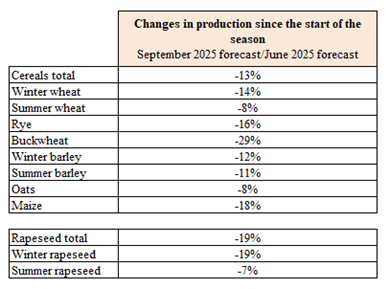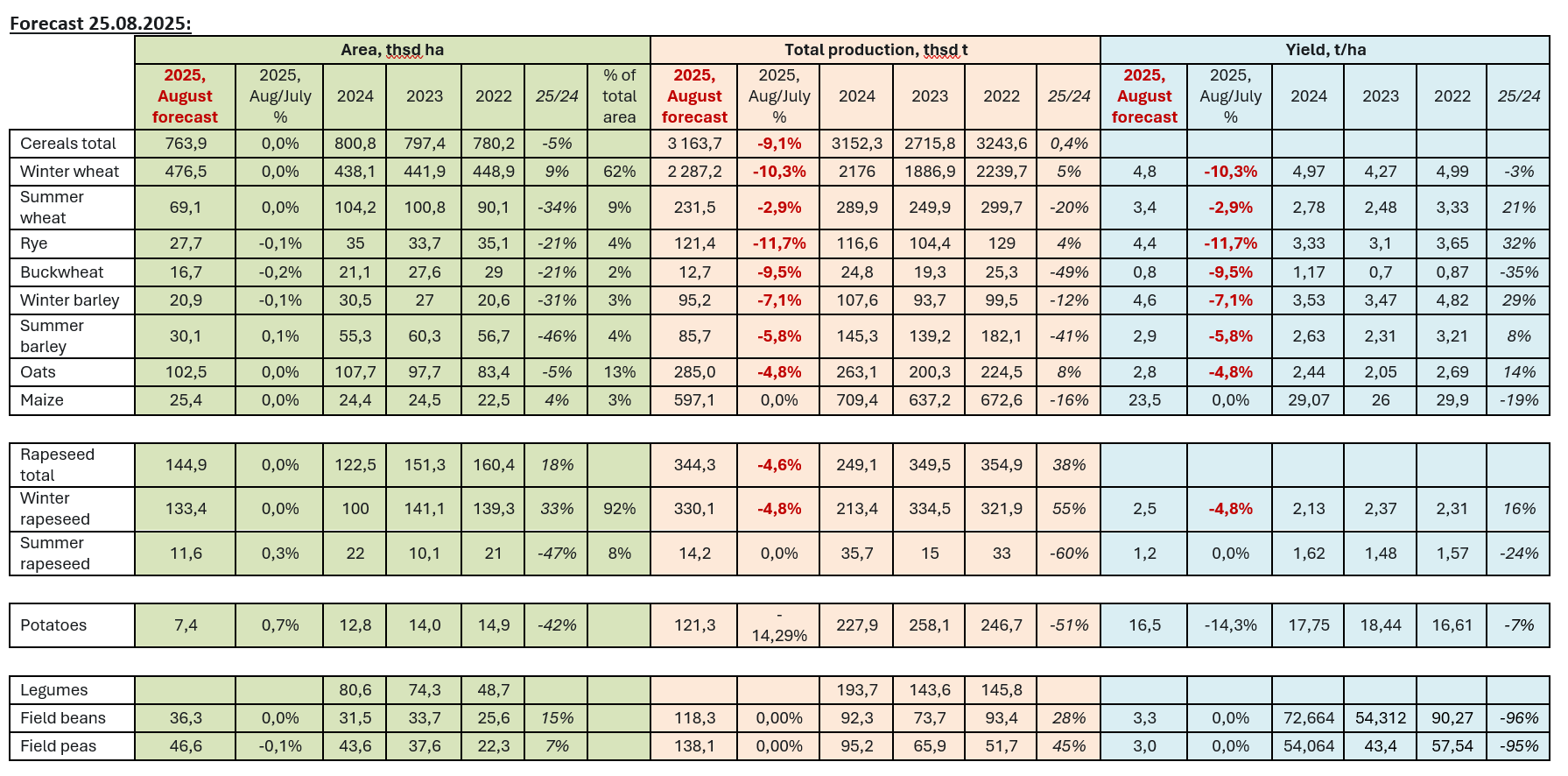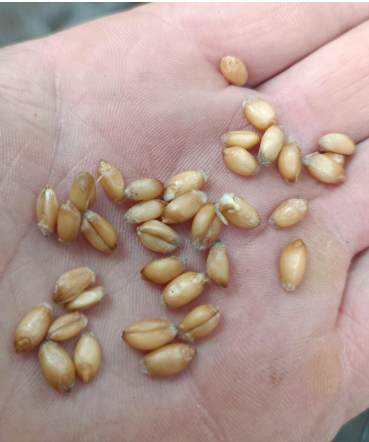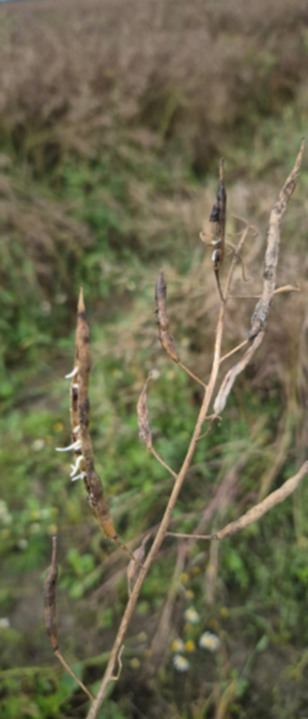The results of crop, rapeseed and potato yield forecasting carried out by specialists of the crop production department of the Latvian Rural Advisory and Training Centre on 25.08.2025 show that, compared to the forecasts of July 2025, the total crop production has been reduced by 9.1%. The situation has worsened since July.
Updated: 15.10.2025.
The crop yield forecast for cereals, rapeseed, potatoes, field beans, peas and maize carried out by specialists of the Latvian Rural Advisory and Training Centre on 23 September 2025 shows that the total production for almost all summer crops have decreased compared to the August forecast: maize (-14.9%), buckwheat (-5.3%), summer wheat (-3.7%), summer barley (-3.5%) and oats (-1.4%). The total production of field beans and field peas also decreased by -3.1% and -12.8% respectively.
The decrease is mainly due to a drop in yields.
Reduction in the total production since the beginning of the season
Looking at the data against the initial estimates of the season, it can be concluded that the total cereal production in 2025 is expected to be significantly lower than initially forecasted in June this year.
The 13% decrease in the total cereal production compared to the June forecasts indicates widespread yield losses affecting both winter and summer crops.
Buckwheat, winter rape, maize and rye are among the most severely affected by adverse agro-climatic conditions. Total wheat production is also decreasing for both winter and summer crops: winter wheat -14%, summer wheat -8%.
Crop development and yield potential
Summer cereals are cultivated in most areas. The rains caused a delay in the summer sowing.
The highest yields of summer wheat were made in Zemgale region, where food-grade grains were obtained. However, for certain varieties, the bulk density of the grain did not ensure food quality. As a result of the wet conditions, the summer crops had shorter ears and small grains were obtained. In the Vidzeme region, summer wheat had lower yields than winter wheat, however, the harvest corresponded to food quality.
Summer barley was sown later, after frosts, followed by a period of rain. Therefore, it was not possible to obtain optimal yields.
Oats, which were sown on time, obtained higher yields, while those sown later did not fully develop.
Buckwheat in Kurzeme region is in the ripening stage, but in Latgale region and Vidzeme region it is just beginning to ripen. Later sown buckwheat still blooms. In Latgale region, under the influence of moisture, buckwheat is weedy and less developed.
Harvesting of summer rapeseed in Latgale region and Vidzeme region has just begun. Moisture conditions have contributed to the formation of small seeds, and weeds have taken over the flooded areas. Most rapeseed harvested in Vidzeme region has a low oil and protein content.
Potato yields varied significantly between regions: because of rainfall in Latgale region and in some parts of Vidzeme region, the potato tubers drowned out and due to excessive moisture, they will not be stored. The rest of Latvia has moderate yields. In Latgale region, the possibilities of obtaining seed material are also of concern, as small tubers are collected.
The yield of field peas was significantly influenced by their sowing time. Peas sown earlier in Zemgale and Kurzeme regions formed a stronger root system, increased biomass, ripened faster and were harvested before the rain period, resulting in a relatively good harvest. There were few pests in the peas. In turn, later sown peas in Vidzeme and Latgale regions, under the influence of rain, drowned and did not develop, in many places grew into weeds. As a result of frequent rainfall, peas could not be harvested, a large part of the crops laid flat and peas were knocked out of the pods, as a result of which part of the area was ploughed, as it was impossible to harvest.
Field beans started to harvest, but harvesting is affected by frequent precipitation. The productivity of the sowing depends on the variety, the time of sowing and the moisture supply. In Zemgale region, where moisture was optimal, a good harvest was obtained, but in Latgale and Vidzeme regions, due to excessive moisture, the number of bean pods and the weight of seeds decreased.
In regions with less rainfall, maize plants developed better there. As a result of excessive humidity in Latgale region and part of Vidzeme region, the biomass of maize has been reduced, with plants not exceeding 1.5 meters in height. The number of cobs has also been affected, with one cob forming in weter fields and up to two cobs forming in better fields, which determine the yield level.
Winter sowing
Now, there have been significant delays in the sowing of winter crops, which raises concerns about the level of harvest for the coming year. In Vidzeme and Latgale region, due to excessive humidity, it was not possible to sow winter rapeseed. Later sown rapeseed is currently in the germination stage and has reached the development phase of two true leaves, which poses an increased risk for its further development and successful wintering. If in previous years farmers were able to apply reduced tillage, then as a result of excessive humidity, this year large areas are ploughed in order to be able to sow winter crops.
Most cereal crops, including winter and summer wheat, rye, buckwheat, barley, and oats, have experienced a decrease in total production from 2.9% to 11.7% compared to the July forecast. In addition, grain quality indicators have decreased significantly, resulting in a high proportion of harvested grains not being of food quality and being placed in the feed class.
Total production:
For winter wheat, which accounts for most of the cereal area, the total production forecast for August has been reduced by 10.3% and for summer wheat by 2.9%. A similar trend can be observed in rye, buckwheat and barley. The total production of rapeseed is forecast to decrease by 4.6% compared to the July forecast, mainly due to the drop in winter rapeseed yield, although the area has not changed. Due to the adverse weather conditions, part of the rapeseed suffered from frost in the spring, while under the influence of wind and rain the plants laid flat, and under the influence of moisture sprouted seeds were found in the seed pods, which significantly affects the quality and marketability of the rapeseed.
Potatoes are forecast to see a significant drop in total production in August, by 14.3%, which has been affected by a decrease in both area and yield.
Delayed harvesting:
Crop development and harvest potential throughout Latvia is significantly affected by excessive moisture in the soil and rainfall, which significantly delays harvesting operations.
Winter crops harvesting started about 10 days later than usual and two weeks later than last year, when the plants ripened faster as a result of the heat.
This year, winter barley was first cultivated, followed by winter rapeseed harvesting in Zemgale and Kurzeme, but in Vidzeme and Latgale they were only partially harvested, because harvesting was difficult in many places due to rainfall, and it had not yet matured. In parallel, rye continued to be harvested, but under the influence of heavy rain and wind, in many places it has been laid flat and still has not been harvested. Weeds have already grown through the lodged rye fields, which will make it difficult to harvest them and the quality of the grain decreases due to rainfall. The actual harvesting of winter wheat started only around 5 August (usually starting around 25 July and last year around 21 July). During this time, problems also emerged: flooded fields, drowned agricultural machinery, rain-damaged access roads. The continuation of rainfall made harvesting much harder until August 12 in Zemgale and Kurzeme. Due to the uneven formation of precipitation clouds, harvesting was only possible in certain places in Vidzeme and Latgale. In Zemgale the winter wheat harvest is coming to an end, in Kurzeme about 60-70%, in Vidzeme and Latgale the winter wheat areas have been harvested only about 40-60%. According to the observations of farmers on the Gulbene area, intensive harvesting of winter crops was possible for only 4 days.
Winter rapeseed has been cultivated throughout Zemgale, Kurzeme – around 80%, Vidzeme and Latgale – between 50 and 60% of the sown area. Winter rape has drowned out in some places and damages of the stem weevils reduced seed coarseness.
Harvesting of summer crops - summer wheat, barley and oat harvesting has begun in all regions. Earlier sown summer crops had a more developed root system, resulting in higher yield potential. On the other hand, the late summer sowings suffered from a significant lack of air in the roots due to excessive humidity, weaker plants, shorter ears and a reduction in the productivity of the ears. Summer crops in Zemgale and Kurzeme had more optimal soil moisture, the plants developed stronger and created better yield potential compared to Vidzeme and Latgale. In these regions, the fields are rare and weedy, as excessive humidity did not allow to carry out crop maintenance work. Cereals developed shorter ears, reduced number of grains in the ear and grain coarseness. In the Latgale region, it is possible that summer crops with green cover will not be harvested because green cover have overgrown summer wheat and barley, but oats will be rolled into silage. Excess moisture in Latgale also affected the development of buckwheat, as a result of which plants were formed shorter, less developed with a smaller number of inflorescences. In many places, buckwheat will not be harvested, because the fields are too wet, and it is not economically viable to harvest under such conditions. The buckwheat, which was sown in early June, will be incorporated into the soil as green manure in certain areas.
There is a risk that up to 35% of summer crops in Vidzeme region may not be cultivated due to rainfall.
Overall, harvesting is proceeding very slowly, hampered by constant rain and waterlogged soil. In wet weather conditions, it is impossible to harvest grain with optimal moisture content, which significantly increases grain drying costs. Winter rapeseed sowing has been delayed in many places. While in Zemgale and Kurzeme, where weather conditions were drier, winter wheat harvesting began earlier, in Vidzeme and Latgale, rapeseed sowing cannot begin due to excessively wet soil, which may significantly reduce rapeseed acreage next year.
The quality of the harvested grains:
The wet soil during the growing season did not allow the grains to fully develop and their bulk density is 20-25% lower, which also reduces the expected yield level and quality indicators. For part of winter wheat, the protein and gluten content are in line with food quality requirements, but the low bulk density does not ensure the quality of the food grain.
In total, the quality of the harvested winter wheat grains (before pre-treatment) in 85-90% of cases (in all regions) is included in the feed class. After cleaning and drying of the grain, the indication of the bulk density may improve slightly.
Due to the late start of harvesting and the increased humidity level in wheat grains (around 17-20%), at which they are cultivated, grain pre-treatment and logistics are also hindered. For the long-term storage and marketing of wheat, the moisture level should be reduced to a maximum of 14%. Road transport, which is necessary on the field at harvesting, forms rows and delays at grain elevators. The same transport is also needed for grain logistics to ports. This year, all these processes take place simultaneously, which is a challenge for all involved.










